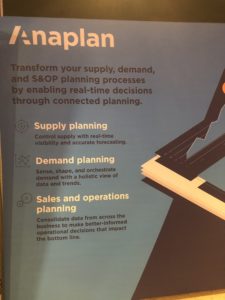It is 1:00 AM in Antwerp. I cannot sleep. As I stare at t he keyboard sitting on my desk, my view is the train station draped in darkness. The quiet streets await the coming of the soft snow. It seldom snows in Belgium: the city sits in anticipation.
he keyboard sitting on my desk, my view is the train station draped in darkness. The quiet streets await the coming of the soft snow. It seldom snows in Belgium: the city sits in anticipation.
I hate jet lag. There is nothing worse than trying to sleep when you cannot, and you know that you should. So instead of wearing out the sheets, I thought that I would do some blogging. Maybe as I type, my body will crave sleep.
This week in my travels I posed a question to myself. “Where would the supply chain technology industry be without all of the bulls#&t?” Based on my research, it is clear to me that buyer frustration with supply chain technology is increasing. Progress on the key performance metrics of cost, customer service, inventory, and Return on Invested Capital (ROIC) are going backward; not forwards, for most companies. The lack of progress is troubling. Only one in three business leaders feel that their supply chain performs well.
As I stare at my keyboard, I wonder what would have happened if the dialogue on supply chain improvement, over the last decade, was more data-driven with less vendor hype.
Let me share some stories. In this blog, I will focus on current market confusion. Specifically, I will focus on the lack of clear market definitions of the terms control tower, cognitive computing, connected planning, and concurrent planning.
Control Tower
Last week, a major strategy consultant asked a question about control towers. The dialogue quickly became circular. Here is my memory of the discussion:
“Hi, I am Lora. How can I help you?”, I said.
The raspy voice on the other end of the phone stated, “Can you share your experience on the implementation of control towers. What is best practice?”
I laughed, and said quietly, “What are you trying to control?” (For me the discussion of a control tower is an industry rabbit hole. What do I mean? It is a concept that sounds good, but due to lack of definition never goes anywhere.)
Frustrated, the consultant’s voice rose an octave. “What do you mean? Aren’t Descartes, GT Nexus, JDA, Fourkites, Kinaxis or OM Partners control towers? Which is better?”
Softly, I asked, “What is your goal? What is your client trying to measure and gain control of? Each of these solutions is quite different.” (I find that companies state that they want a control tower, but are not clear on what they are trying to control. Each technology provider also drapes their solution in ambiguous, generic descriptions. As a result, the discussions become circular.)
I then shared, “I see many companies attempting to implement control tower projects without a goal in mind. Yesterday, I was at a client that proudly showed sexy screens. Yet, they were viewing day-old information. How helpful is that? The data was out of sync with their needs. When I asked the client the value of the project, they were not sure that there was one. Their control tower approach, due to data latency, had not improved operations. It fell short of expectations.”
Pausing, I reiterated, “I would start the discussion with the Chief Operating Officer. The most important question to ask is what is the goal. How will the client measure success? Then determine is the project targeted to improve visibility, control and improve an outcome or drive continuous improvement. Each objective has a different project requirement.”
The consultant, now, very frustrated, stated, “Isn’t the goal clear?” The voice was now two octaves higher. The demeaning tone quickly made me feel like the dumbest analyst in the world. I swallowed and shook off my emotions.
“No,” I continued. “There is no industry standard definition for a control tower. Let’s take some examples. While telematics providers all use the term ‘control tower’, real-time visibility of truck status needs to be connected/compared to a planning system of record. This can take many forms. It can be compared to estimated time of delivery in transportation planning, or to customer booking data to compare on-time delivery, but the reference data varies by mode. The system needs to be built with the goal in mind.” (Each mode of transport has different comparison reference data.)
“Enterprise solutions are complex,” I continued. “Within the company, the average company has seven ERP systems, five telematics solutions and five Advanced Planning Solutions. Forty percent of shipments move through 3PLs. The use of third parties introduces data latency issues. To track data and drive ‘control’, the data needs to be synchronized and compared against reference data with the goal in mind.”
“Why then do all of the vendor’s websites list control tower functionality?”, asked the consultant.
My answer? Over-hyped marketing. The term control tower is over-hyped; and as a result, lacks meaning. The answer is not simple. I know of no success in control towers that are not dependent on a data lake for data harmonization and synchronization. I also do not know a team that has been successful implementing a solution across make, source and deliver processes without clearly defined goals and process workflows. While the term control tower sounds good on a vendor’s website, the reality is quite different. As a result, most control tower projects sound good but go nowhere.
Advanced Analytics
In a similar vein, I discussed the evolution of machine learning and cognitive computing with a client last week. It seems that all of the technology presentations are now dripping with promises of cognitive computing. However, what I find, is a lack of definition. Most technology providers are using yesterday’s definitions of planning using machine learning to clean data through pattern recognition. They are painting inside the box versus thinking outside of the box.
The market is awash with terms. We are in a spin cycle of digital innovation.
My questions for the technologists were, “How do you define cognitive?” With hearing this question, most will answer with silence. Only Enterra answers the question with the definition of a semantic inference engine. Instead, most of the solutions are aligning data using machine learning or improving planning models through better use of math. Few are driving innovation to drive autonomous supply chain planning through better management of exceptions (not just showing the exceptions, but giving suggested action), or implementing learning engines to sense, learn and act to improve the rule-sets of the supply chain. This would include rules like inventory matching, customer policy, Available-To-Promise (ATP) or allocation. …or a learning engine on top of software bots to improve directed workflow. Sadly, there is little progress in this area from large companies like Anaplan, Oracle, SAS, or SAP. JDA and OM Partners are dabbling on the edges.
Figure 1. The Application of Advanced Analytics to Supply Chain Management

Connected Planning.
Connected planning is the rallying cry for Anaplan. The Company is attempting to define a new category and shift traditional taxonomy definitions.
The concept behind Anaplan’s brand promise is to connect finance, sales, marketing an d supply chain data in a meaningful way. I like the concept. I dislike the execution.
d supply chain data in a meaningful way. I like the concept. I dislike the execution.
What Anaplan does well is workflow and “what-if” analysis. The solution is intuitive and easy to use. (Traditional APS solutions in contrast are not easy to use.) However, Anaplan is not a demand or supply chain modeling technology. Modeling is all about better math.
The larger the organization, this type of collaboration for non-supply chain planning teams is valuable. Unfortunately, due to a fundamental lack of understanding of supply chain planning market, Anaplan is making hollow claims and spinning hype into the market by positioning themselves as a modeling provider. The marketing messages extend beyond capabilities. It is a complimentary solution, but not a replacement for APS technologies.
While the marketing is strong, the product is not equal to the claims. On the left, I show a picture I took with my iPhone of a trade booth used by Anaplan at a European conference. The issue? Anaplan does not have supply and demand modeling capabilities; yet claim to.
Supply chain optimization and modeling is all about data modeling. Anaplan can compliment the use of planning solutions by making the data output more consumable, but lacks core capabilities. The tradeshow booth and Anaplan’s marketing is misleading.
I find clients implementing Anaplan to replace Excel spreadsheets. This is no trivial task since 68% of planning is done through spreadsheets. Employees love the Anaplan user interface, and as a result, the use of the technology spreads quickly across the organization. The end result? Disconnected planning. …an extreme deviation from the brand promise of connected planning.
Concurrent Planning
There are three definitions in the industry for concurrent planning. This includes:
-The use of an in-memory model to drive visibility of plan changes with minimal latency for large planning teams. For example, when companies use Kinaxis, when planner A makes a change in the plan it is seen by planners B-Z without a delay. This is not the case of technologies like JDA, Logility or SAP IBP.
-Collapsing the planning horizons of strategic, tactical, operational and executional planning. The focus of this discussion is to streamline planning; however, I find this discussion worrisome. In most organizations, there is a need for each of these distinct workflows at a process level. However, this discussion is spun as an irrational message into the market with much hype.
-Semantic reasoning. The use of an ontology to sense, learn and act across time horizons and improve data flows. This includes consumption logic across time horizons.
These are very different definitions. What to do? When you hear the term, stop the speaker and ask for a definition. This may seem uncomfortable, but it is difficult to have a discussion without clarity.
The sun is rising. I need to run to my meeting. In my jet-lagged state, I will make it through my day and into seat 13E back to the states tomorrow. I hope that this blog post helps to debunk market hype. I would love for us to move past marketing spin cycles to drive real results, but this is difficult in today’s market.
I welcome your thoughts. Until next time….







